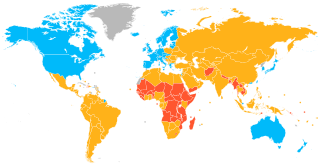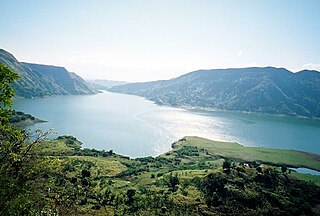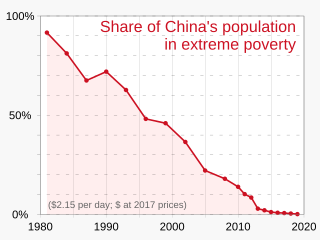
Extreme poverty is the most severe type of poverty, defined by the United Nations (UN) as "a condition characterized by severe deprivation of basic human needs, including food, safe drinking water, sanitation facilities, health, shelter, education and information. It depends not only on income but also on access to services". Historically, other definitions have been proposed within the United Nations.

Corporatocracy is an economic, political and judicial system controlled by business corporations or corporate interests.

Poverty is a state or condition in which one lacks the financial resources and essentials for a certain standard of living. Poverty can have diverse environmental, legal, social, economic, and political causes and effects. When evaluating poverty in statistics or economics there are two main measures: absolute poverty compares income against the amount needed to meet basic personal needs, such as food, clothing, and shelter; relative poverty measures when a person cannot meet a minimum level of living standards, compared to others in the same time and place. The definition of relative poverty varies from one country to another, or from one society to another.

A developing country is a sovereign state with a less developed industrial base and a lower Human Development Index (HDI) relative to other countries. However, this definition is not universally agreed upon. There is also no clear agreement on which countries fit this category. The terms low and middle-income country (LMIC) and newly emerging economy (NEE) are often used interchangeably but refers only to the economy of the countries. The World Bank classifies the world's economies into four groups, based on gross national income per capita: high, upper-middle, lower-middle, and low income countries. Least developed countries, landlocked developing countries and small island developing states are all sub-groupings of developing countries. Countries on the other end of the spectrum are usually referred to as high-income countries or developed countries.
Neoliberalism, also neo-liberalism, is a term used to signify the late-20th century political reappearance of 19th-century ideas associated with free-market capitalism. The term has multiple, competing definitions, and is often used pejoratively. In scholarly use, the term is frequently undefined or used to characterize a vast variety of phenomena, but is primarily used to describe the transformation of society due to market-based reforms.

Economic inequality is an umbrella term for a) income inequality or distribution of income, b) wealth inequality or distribution of wealth, and c) consumption inequality. Each of these can be measured between two or more nations, within a single nation, or between and within sub-populations.
Accumulation by dispossession is a concept presented by the Marxist geographer David Harvey. It defines neoliberal capitalist policies that result in a centralization of wealth and power in the hands of a few by dispossessing the public and private entities of their wealth or land. Such policies are visible in many western nations from the 1970s and to the present day. Harvey argues these policies are guided mainly by four practices: privatization, financialization, management and manipulation of crises, and state redistributions.
In economics, a cycle of poverty or poverty trap is when poverty seems to be inherited causing subsequent generations to not be able to escape it. It is caused by self-reinforcing mechanisms that cause poverty, once it exists, to persist unless there is outside intervention. It can persist across generations, and when applied to developing countries, is also known as a development trap.
Feminization of poverty refers to a trend of increasing inequality in living standards between men and women due to the widening gender gap in poverty. This phenomenon largely links to how women and children are disproportionately represented within the lower socioeconomic status community in comparison to men within the same socioeconomic status. Causes of the feminization of poverty include the structure of family and household, employment, sexual violence, education, climate change, "femonomics" and health. The traditional stereotypes of women remain embedded in many cultures restricting income opportunities and community involvement for many women. Matched with a low foundation income, this can manifest to a cycle of poverty and thus an inter-generational issue.

Poverty reduction, poverty relief, or poverty alleviation is a set of measures, both economic and humanitarian, that are intended to permanently lift people out of poverty.

Poverty is measured in different ways by different bodies, both governmental and nongovernmental. Measurements can be absolute, which references a single standard, or relative, which is dependent on context. Poverty is widely understood to be multidimensional, comprising social, natural and economic factors situated within wider socio-political processes.

The Péligre Dam is a gravity dam located off the Centre department on the Artibonite River of Haiti. At 72 m (236 ft) it is the tallest dam in Haiti. The dam was created as a flood-control and an energy-providing measure in the Artibonite River Valley during the 1950s, as part of the Artibonite Valley Agricultural Project. This dam impounds Lake Péligre.

In China today, poverty refers mainly to the rural poor. Decades of economic development has reduced urban extreme poverty. According to the World Bank, more than 850 million Chinese people have been lifted out of extreme poverty; China's poverty rate fell from 88 percent in 1981 to 0.7 percent in 2015, as measured by the percentage of people living on the equivalent of US$1.90 or less per day in 2011 purchasing price parity terms, which still stands in 2022.
Poverty in Canada refers to the state or condition in which a person or household lacks essential resources—financial or otherwise—to maintain a modest standard of living in their community.

In the United States, poverty has both social and political implications. In 2020, there were 37.2 million people in poverty. Some of the many causes include income inequality, inflation, unemployment, debt traps and poor education. The majority of adults living in poverty are employed and have at least a high school education. Although the US is a relatively wealthy country by international standards, it has a persistently high poverty rate compared to other developed countries due in part to a less generous welfare system.
The economic liberalisation in India refers to the series of policy changes aimed at opening up the country's economy to the world, with the objective of making it more market-oriented and consumption-driven. The goal was to expand the role of private and foreign investment, which was seen as a means of achieving economic growth and development. Although some attempts at liberalisation were made in 1966 and the early 1980s, a more thorough liberalisation was initiated in 1991.

Rural poverty refers to situations where people living in non-urban regions are in a state or condition of lacking the financial resources and essentials for living. It takes account of factors of rural society, rural economy, and political systems that give rise to the marginalization and economic disadvantage found there. Rural areas, because of their small, spread-out populations, typically have less well maintained infrastructure and a harder time accessing markets, which tend to be concentrated in population centers.
Bangladesh is an under-devoloped nation. Despite rapid economic growth, poverty remains a major issue. However, poverty has declined sharply in recent history. Shortly after its independence, approximately 90% of the population lived under the poverty line. However, since economic reforms and trade liberalization of early 1990s, along with accelerated economic growth since early-2000s, Bangladesh have experienced a dramatic progress in reducing poverty. The remarkable progress in poverty alleviation has been recognized by international institutions. According to World Bank, more than 33 million Bangladeshi people have been lifted out of poverty since 2000; as measured by the percentage of people living on the equivalent of US$1.90 or less per day in 2011 purchasing price parity terms.
Kenya is a upper-middle income economy as of 2024, with kenya's GDP 2024 hitting [[204.6B $]]. This is Due to increasing technology innovation Services. Although Kenya's economy is the largest and most developed in eastern and Central Africa, 16.1% (2023/2024) of its population lives below the international poverty line. This severe poverty is mainly caused by economic inequality, government corruption and health problems. In turn, poverty also worsens these factors. The Kenyan government's efforts to address poverty have received help from international institutions as well. The incident rate of poverty has steadily decreased, as shown by a recent MPI index.

Jason Edward Hickel is an Eswazi anthropologist and professor at the Autonomous University of Barcelona. Hickel's research and writing focuses on economic anthropology and development, and is particularly opposed to capitalism, neocolonialism, as well as economic growth as a model of human development.




















